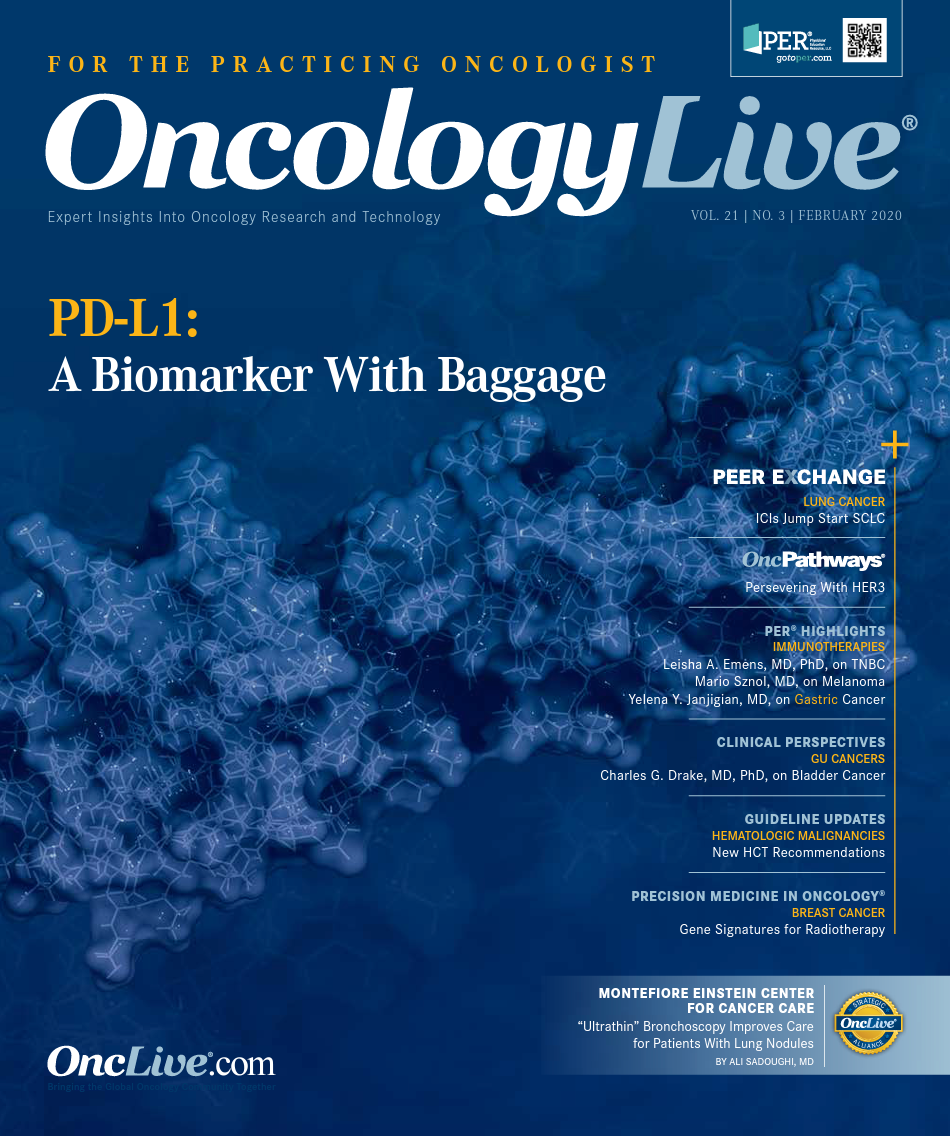Publication
Article
Oncology Live®
New Chapter Opens in Bladder Cancer Treatment
Author(s):
For years, the treatment landscape for bladder cancer was defined by lackluster consistency: There were no advances. However, the drought ended with the introduction of immune checkpoint blockade, according to Charles G. Drake, MD, PhD.
Charles Drake, MD, PhD

Charles Drake, MD, PhD
For years, the treatment landscape for bladder cancer was defined by lackluster consistency: There were no advances. However, the drought ended with the introduction of immune checkpoint blockade, according to Charles G. Drake, MD, PhD.
The first immunotherapeutic approvals in bladder cancer occurred between 2016 and 2017. In this period, the armamentarium expanded to include 5 immune checkpoint inhibitors (ICIs) for the treatment of platinum-resistant metastatic disease: atezolizumab (Tecentriq), nivolumab (Opdivo), durvalumab (Imfinzi), avelumab (Bavencio), and pembrolizumab (Keytruda).
In April 2019, the field gained its first targeted agent, erdafitinib (Balversa), an oral fibroblast growth factor receptor (FGFR) kinase inhibitor indicated for patients with locally advanced or metastatic bladder cancer harboring activating FGFR 2/3 mutations or fusions.1 The second precision therapy arrived in December 2019, when enfortumab vedotin-ejfv (Padcev) was approved for patients with locally advanced or metastatic urothelial cancer who were previously treated with a PD-1 or PD-L1 inhibitor and a platinum-containing chemotherapy in the neoadjuvant, adjuvant, locally advanced, or metastatic setting. Enfortumab vedotin targets Nectin-4, a protein that is highly expressed in bladder cancer.2
Most recently, pembrolizumab was cleared for use in the treatment of patients with Bacillus Calmette-Guérin-unresponsive, highrisk, nonmuscle invasive bladder cancer with carcinoma in situ with or without papillary tumors who do not qualify for cystectomy.3
An enhanced understanding of tumor biology and oncogenic drivers kick-started fresh progress in bladder cancer, and more advances are in the offing. As in other disease settings, actionable drivers await discovery and development of precision therapies continues to evolve. Also, the treatment paradigm—advancing potential of immunotherapeutic combinations is unclear and requires further study.
In an interview with OncLive®, Drake discusses the shifts that shaped bladder cancer therapy in recent decades, the unmet need that remains, and novel agents under development. Drake is the codirector of Cancer Immunotherapy Programs and coleader of the Tumor Biology and Microenvironment Program at Columbia University Herbert Irving Comprehensive Cancer Center in New York, New York.
OncLive: Please describe the biggest changes in the treatment landscape for urothelial carcinoma over the past 20 years.
Drake: Bladder cancer was boring for a very, very long time. At the ASCO [American Society of Clinical Oncology] annual meetings, urothelial carcinoma would be the last session on the last day; everybody would go home before it.
It was the same thing year in and year out—a little tweaking of chemotherapy, things like that. Nothing happened in bladder cancer until a couple of years ago, when the immune checkpoint molecule arrived on the scene. The first agent to show activity was atezolizumab. Single-arm data demonstrated that atezolizumab led to a response rate of 15% to 20% in patients whose disease progressed on prior platinum-based therapy. But what really changed the landscape was that some of these responses were complete and durable. The average length of response was not hugely different with the ICI compared with chemotherapy, but some of the durable responses lasted for many years. That was really the first big change in many years, and so people started coming to the ASCO sessions.
What happened next was interesting. Basically, all the immune checkpoint drugs that are approved today were approved in bladder cancer, but they were approved based mostly on single-arm studies, which was unusual. And the reason that they were approved was because there wasn’t a good second-line chemotherapy. The only exception was pembrolizumab, which was approved based on a randomized trial. In the second line after chemotherapy, pembrolizumab is the only drug that really has evidence of activity.
Genentech later conducted a randomized trial of atezolizumab, and interestingly, it was negative. So the question became “What happens next? Does the FDA tell [physicians] to stop using atezolizumab in the second line?” It ultimately remained approved in the second line, which is probably the biggest and clearest paradigm shift in that the majority of patients receive firstline chemotherapy and then get an ICI when their disease progresses.
Another question that has been important in bladder cancer is “If something works well in later lines, does it work better if you give it earlier?”
A lot of these patients are just not healthy enough to get a lot of chemotherapy; these are the cisplatin-ineligible patients. In the very first trial of atezolizumab, there was an arm of patients who were cisplatin ineligible. The response rate was around the same as for chemotherapy, around 15% to 20%. Both atezolizumab and pembrolizumab got approved for cisplatin-ineligible patients, and we were all merrily going along treating patients with these drugs in the first line.
In 2018, the FDA proclaimed with no data that first-line immune checkpoint blockade is no longer approved for cisplatin-ineligible patients unless the patient’s tumor expresses PD-L1.4
And what that inherently means for those patients is that chemotherapy such as carboplatin should probably be used unless they’re PD-L1 positive. It’s very unusual to have a proclamation like this with no data, so that led to bit of uncertainty in the first line. If somebody is not eligible for cisplatin, do you give them carboplatin? Do you stain for PD-L1 and give them PD-L1 if they’re eligible? What are you really supposed to do? The first line was and remains a little less clear than the second line.
Could any of the pivotal trial data currently awaited have landscapechanging implications?
Several ongoing trials in the first line are randomizing patients to chemotherapy versus an ICI versus a combination of both. The hope is that the combination will elicit really good responses that last a long time. What the FDA ruling suggests is that if you’re getting carboplatin and you’re PD-L1 negative, you would probably do better on the carboplatin than you would on a PD-1 or PD-L1 drug.
We saw the first bit of data from these trials at ESMO [European Society for Medical Oncology 2019 Congress], and atezolizumab with chemotherapy looked a little bit better than either chemotherapy alone or immunotherapy alone.5 All the companies testing their approved ICIs in these trials will come out with their data. Based on prior activity in other cancers, the optimal first-line therapy for most patients [with bladder cancer] is probably going to be a combination of chemotherapy and immune checkpoint blockade. I suspect that by the end of 2020, we’ll have a clear picture of first-line treatment in bladder cancer.
What are the prospects for improving treatment earlier in the timeline?
Anti—PD-1 is good. It has response rates, probably in the 15% to 25% range, but that excludes about 75% of patients with tumors that do not respond. So, if we give 2 immune drugs, will that work better? This question has been asked in melanoma and kidney cancer. There are trials testing first-line anti–PD-1 versus anti–PD-1 plus anti– CTLA-4 versus chemotherapy. Data from these first-line trials will emerge, probably over the next year or 2, and have potential to expand earlier treatment options.
Another promising candidate is enfortumab vedotin. It had an amazingly good objective response rate for patients whose disease progressed on immunotherapy [44%; 95% CI, 35.1-53.2], and the disease control rate as shown by waterfall plots is also really good [84%; 92 of 110 patients].6 It’s a very attractive drug but the challenge is that you’ve got to keep giving it to patients.
Please comment on the progress of targeted therapy in bladder cancer.
Although it’s probably not as transformative as ICIs were, erdafitinib was recently approved and is a great second-line option for patients who have FGFR2 and FGFR3 mutations.
What people are not paying as much attention to as they should is HER2/neu. We always forget that, like breast cancer, bladder cancer has a reasonable population of patients who express HER2/neu. The expression is kind of on the lower side, so trastuzumab [Herceptin] has not been very effective in bladder cancer, but there is a new drug called [fam-] trastuzumab deruxtecan-nxki [Enhertu], and this is an antibody-drug conjugate that is strikingly effective in second- and third-line breast cancer.
It has saved many patients whose disease was progressing on trastuzumab or T-DM1 [trastuzumab emtansine; Kadcycla]. This is a dynamite anti-HER2 drug that’s asking people to reevaluate bladder cancer and say, “If you have HER2-positive disease should you get T-DM1?”
[The Tisch Cancer Institute at the Mount Sinai School of Medicine in New York, New York] is running a trial [NCT03523572] of trastuzumab deruxtecan in HER2-positive bladder cancer, and if its efficacy is anything like it is in breast cancer, it could be another agent that has a high impact. You don’t usually think of HER2 when you think of bladder cancer, but if we’re going to try to do targeted therapy, this is a viable target that is well validated in breast cancer.
What are the areas of unmet need?
There are 2 main areas of unmet need. The first is earlier treatment. Say somebody has muscle-invasive bladder cancer; they go to surgery, and their disease looked bad. In general, cystectomy probably cures about 40% of patients with bladder cancer, but there are patients for whom this procedure won’t lead to a cure. The question there as in other cancers is: “Can you do something that adds to the surgery in the adjuvant setting?” ICIs have been tested there. Right now the adjuvant space is an area of unmet need in bladder cancer.
A number of adjuvant trials have been giving checkpoint blockade—namely, atezolizumab and pembrolizumab—after surgery in patients who look like they’re at high risk of recurrence. Those trials take a long time because [they’re] waiting to see if the disease is going to come back. Maybe we’ll see some data toward the end of next year or early next year on whether adjuvant immunotherapy will help.
The other area of unmet need is in treating patients whose disease progresses. Even in the best immunotherapy trials, most patients’ disease progresses, so we really do need therapies that can lead to complete responses that persist when the patient is off treatment. An aspirational goal for bladder cancer is to have agents that give patients a long treatment-free survival.










